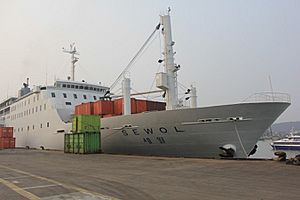Sewol facts for kids
The ferry MS Sewol was on a trip from Incheon to Jeju Island, off the southern coast of South Korea. On April 16, 2014, it sank near Jindo Island, which is off the southwest coast. This sad event led to the loss of 304 lives.
Contents
What Was the MS Sewol?
The MS Sewol was a large passenger ferry. It was built in Japan in 1994 and could carry many people and vehicles. Ferries like the Sewol are important for travel between islands and the mainland in places like South Korea. They help people visit family, go on holidays, or transport goods.
The Ferry's Design
The Sewol was designed to be stable and safe for its journeys. It had several decks for passengers and a large cargo area for cars and trucks. Like all ships, it needed to be loaded correctly to stay balanced.
The Day the Sewol Sank
On the morning of April 16, 2014, the MS Sewol was sailing in calm waters. Suddenly, the ship began to tilt sharply to one side. This tilting happened quickly, making it very difficult for people on board to move around or escape.
Why the Ship Tilted
Investigations later showed that the Sewol was carrying too much cargo. Also, the cargo was not properly secured. When the ship made a turn, the unsecured cargo shifted. This shift caused the ferry to lose its balance and begin to capsize, or turn over.
Rescue Efforts and Challenges
When the Sewol started to sink, many people tried to help. Fishing boats and coast guard vessels rushed to the scene. However, the ship sank very fast, making rescue efforts extremely difficult.
Inside the Sinking Ship
Many passengers, especially students on a school trip, were told to stay in their cabins for safety. This advice, given by the crew, trapped many people as the ship turned over. Brave rescuers worked hard to pull people from the water and the sinking vessel.
Remembering Those Lost
The sinking of the MS Sewol was a very sad event for South Korea. Most of the people who died were high school students. Their loss deeply affected the entire country.
Memorials and Tributes
After the disaster, many memorials were created to remember the victims. People left flowers, notes, and yellow ribbons as symbols of hope and remembrance. The yellow ribbon became a special symbol for the Sewol tragedy.
Changes After the Sinking
The Sewol disaster led to many important changes in South Korea. The government and shipping companies worked to improve safety rules for ferries.
New Safety Rules
New rules were put in place to make sure ships do not carry too much weight. There are also stricter checks to ensure cargo is tied down properly. Training for ship crews was also improved, focusing on how to act quickly and safely in an emergency. These changes aim to prevent such a tragedy from happening again.


